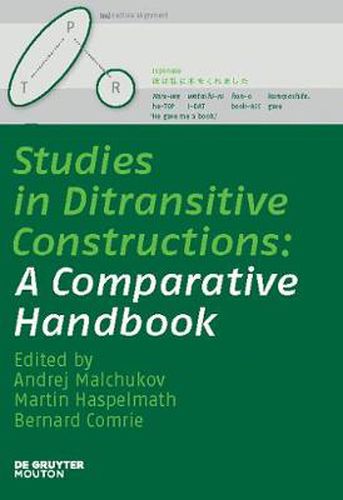Readings Newsletter
Become a Readings Member to make your shopping experience even easier.
Sign in or sign up for free!
You’re not far away from qualifying for FREE standard shipping within Australia
You’ve qualified for FREE standard shipping within Australia
The cart is loading…






This title is printed to order. This book may have been self-published. If so, we cannot guarantee the quality of the content. In the main most books will have gone through the editing process however some may not. We therefore suggest that you be aware of this before ordering this book. If in doubt check either the author or publisher’s details as we are unable to accept any returns unless they are faulty. Please contact us if you have any questions.
This rich volume deals comprehensively with cross-linguistic variation in the morphosyntax of ditransitive constructions: constructions formed with verbs (like give) that take Agent, Theme and Recipient arguments. For the first time, a broadly cross-linguistic perspective is adopted. The present volume, consisting of an overview article and twenty-odd in-depth studies of ditransitive constructions in individual languages from different continents, arose from the conference on ditransitive constructions held at the Max Planck Institute for Evolutionary Anthropology (Leipzig) in 2007. It opens with the editors’ survey article providing an overview of cross-linguistic variation in ditransitive constructions, followed by the questionnaire on ditransitive constructions, compiled by the editors in order to elicit various properties of these patterns. The editors’ overview discusses formal properties of ditransitive constructions as well as behavioral (or syntactic) and lexical properties (i.e., the extension of ditransitive constructions across different verb classes).
The volume includes 23 contributions describing properties of ditransitive constructions in languages from all over the world, written by leading experts. Care has been taken that the contributions to the volume will be representative of structural, geographic and genealogical diversity in the domain of ditransitive constructions. Thus the present volume provides a unique source of information on typological diversity of ditransitive constructions. It is expected that it will be of central interest to all scholars and advanced students of linguistics, especially to those working in the field of language typology and comparative syntax.
$9.00 standard shipping within Australia
FREE standard shipping within Australia for orders over $100.00
Express & International shipping calculated at checkout
This title is printed to order. This book may have been self-published. If so, we cannot guarantee the quality of the content. In the main most books will have gone through the editing process however some may not. We therefore suggest that you be aware of this before ordering this book. If in doubt check either the author or publisher’s details as we are unable to accept any returns unless they are faulty. Please contact us if you have any questions.
This rich volume deals comprehensively with cross-linguistic variation in the morphosyntax of ditransitive constructions: constructions formed with verbs (like give) that take Agent, Theme and Recipient arguments. For the first time, a broadly cross-linguistic perspective is adopted. The present volume, consisting of an overview article and twenty-odd in-depth studies of ditransitive constructions in individual languages from different continents, arose from the conference on ditransitive constructions held at the Max Planck Institute for Evolutionary Anthropology (Leipzig) in 2007. It opens with the editors’ survey article providing an overview of cross-linguistic variation in ditransitive constructions, followed by the questionnaire on ditransitive constructions, compiled by the editors in order to elicit various properties of these patterns. The editors’ overview discusses formal properties of ditransitive constructions as well as behavioral (or syntactic) and lexical properties (i.e., the extension of ditransitive constructions across different verb classes).
The volume includes 23 contributions describing properties of ditransitive constructions in languages from all over the world, written by leading experts. Care has been taken that the contributions to the volume will be representative of structural, geographic and genealogical diversity in the domain of ditransitive constructions. Thus the present volume provides a unique source of information on typological diversity of ditransitive constructions. It is expected that it will be of central interest to all scholars and advanced students of linguistics, especially to those working in the field of language typology and comparative syntax.